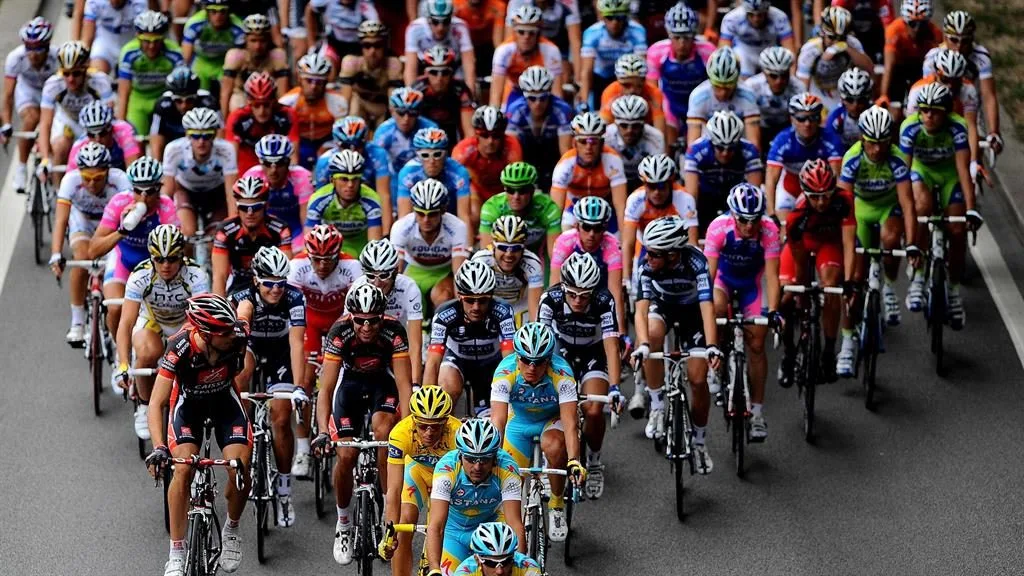
The term “Washing Machine Effect” finds frequent usage within the cycling community. It vividly portrays the intense and dynamic nature of bicycle races, particularly within the peloton, the primary group of riders. This term succinctly encapsulates the rapid shifts in positioning, abrupt changes in speed, and sudden strategy alterations, resulting in a turbulent and swirling scenario akin to clothes in a washing machine. To fully grasp the strategic intricacies inherent in professional cycling, it’s crucial to comprehend this phenomenon.
A peloton, which comprises the primary pack of riders in a bicycle race, can consist of dozens or even hundreds of cyclists in close proximity. When the peloton moves smoothly and predictably, riders can easily maintain their positions and ride safely.
The washing machine effect comes into play when the cyclists in the peloton approach the final stretch of a sprint stage. In these pivotal moments, every cyclist strives for the most advantageous position. This collective desire to lead or secure a spot near the front generates a highly dynamic and ever-changing situation.
Cycling in a Peloton…

Cycling hinges significantly on the art of drafting, where a cyclist strategically utilizes the rider in front as a windbreak, reducing air resistance and enabling them to sustain higher speeds with less exertion. Therefore, cyclists constantly seek to position themselves in the slipstream of others, ideally favoring a position near the front, but not at the very forefront. Leading the pack entails bearing the brunt of wind resistance, while lagging too far behind risks falling out of contention.
Within the framework of the washing machine effect, if a cyclist lacks the requisite strength, skill, or robust team support, they may continually find themselves overtaken by others. This ongoing process can result in the cyclist gradually slipping back within the pack, resembling a piece of clothing tossed around in a washing machine.
Complicating matters further, teams collaborate fervently, striving to optimize their sprinter’s positioning for the final push towards the finish line. Employing tactics and strategies, they maneuver their sprinter through the field, further intensifying the swirling and tumultuous effect.
This perpetual, fluid motion of cyclists vying for prime positions can be chaotic and demanding. It demands a high degree of skill and tactical acumen to navigate successfully. Cyclists must maintain a keen awareness of their surroundings, monitor rival teams and riders, and conserve their energy for the ultimate sprint, all while hurtling forward at astonishing speeds.
Factors to create “Washing Machine Effect”

Several factors contribute to the significant movement and turbulence experienced within the peloton, a phenomenon often dubbed the “washing machine effect.” These elements include:
- Changes in Speed: When the race’s pace abruptly shifts, such as when front riders sprint or tackle ascents, the rest of the peloton must react swiftly. This necessitates position adjustments, resulting in a turbulent reshuffling of riders.
- Wind and Weather: The presence of strong winds, particularly crosswinds, can profoundly disrupt the peloton. Competing cyclists strive to secure positions that offer shelter in the “draft” created by others, leading to extensive position changes.
- Terrain and Obstacles: Sharp turns, narrow roadways, and obstacles like roundabouts introduce chaos into the peloton. Cyclists must swiftly navigate these challenges, often causing rapid and unpredictable shifts in position.
- Attacks and Strategies: Cyclists or teams may execute sudden “attacks” or alter their race strategy on the fly, resulting in rapid shifts in the peloton’s formation.
The combination of these factors continually prompts riders in the peloton to shift and alter their positions, akin to clothes tumbling in a washing machine. This constant state of flux, referred to as the “washing machine effect,” heightens the difficulty and stress levels for cyclists striving to maintain their positions and ride safely.
You might want to read also: What is a Domestique in Cycling? (All You Need to Know)
Frequently asked questions

- What is the Washing Machine Effect in cycling?
The Washing Machine Effect in cycling refers to a rhythmic side-to-side movement experienced while riding. - How does the Washing Machine Effect affect cyclists?
Cyclists may lose stability and control when this motion occurs, potentially leading to accidents. - When does the Washing Machine Effect typically occur in cycling?
It commonly happens when cyclists pedal at certain speeds, causing lateral swaying. - Why is it important to address the Washing Machine Effect?
Acknowledging it helps improve cycling safety and overall riding experience. - What transition words signal the onset of the Washing Machine Effect?
Consequently, riders may experience discomfort or reduced performance. - Can bicycle design influence the Washing Machine Effect?
Yes, bike frame stiffness and geometry can affect its occurrence. - Are there techniques to minimize the Washing Machine Effect?
Cyclists can improve their pedal stroke and adjust their riding position to mitigate it. - Do certain conditions or terrain amplify the Washing Machine Effect?
Riding on uneven surfaces or strong crosswinds can intensify the effect. - What are the potential dangers associated with the Washing Machine Effect?
Riders may risk losing balance and crashing if not prepared. - How can cyclists prepare and respond to the Washing Machine Effect?
Developing core strength and practicing bike handling skills can help cyclists stay in control.









